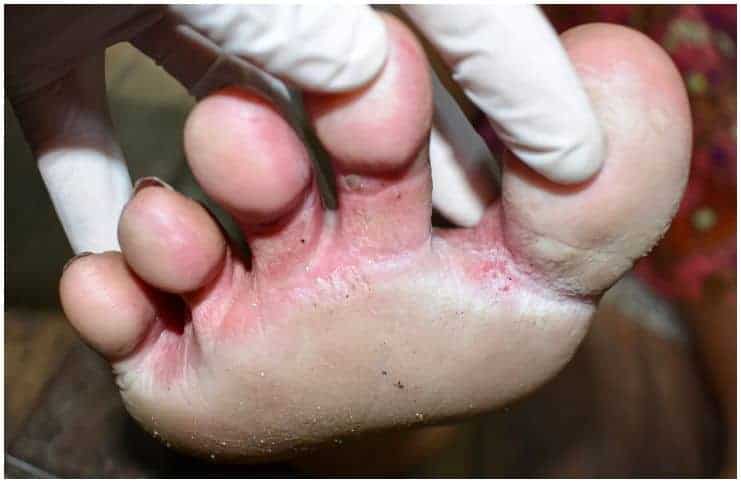Tolnaftate
It is an antifungal cream that is used to clear up conditions such as athlete’s foot (a fungal infection that typically begins between the toes), tinea corporis, tinea capitis, and toenail fungus.
This medicine is available in the following dosage forms: solution, powder, gel/jelly, lotion, cream, spray, and ointment.
Uses
Use this antifungal to the affected skin, usually two times per day or as directed by your doctor or on the product’s package.
Some forms of this medicine (like the powder) require being shaken before applying. But, to be sure 100 percent, check your product package to see if your medication needs to be shaken.
The burning and soreness of the tinea pedis should decrease within 2 to 3 days. However, continue treatment with this medicine for at least 14 days after signs and symptoms disappear with a total of about 4 to 6 weeks of treatment may be required.
Side Effects And Precautions
- contact dermatitis (skin gets red and tender);
- skin inflammation;
- allergic reactions;
- skin irritation;
- rashes;
- redness of the skin;
- irritation of the skin.
Avoid the use of other medicines on the treated area unless directed by your healthcare provider. Do not wash the treated area after immediately using this medicine.
If you are pregnant or breastfeeding a baby, do not use it without your doctor’s advice since it is not known whether this medicine can harm an unborn baby or if it passes into breast milk.
If this drug gets in your nose, eyes, rectum, mouth, or vagina, rinse with cool tap water. Also, it is for use only on the skin, hence, do not take it by the mouth. Also, do not use this medicine on windburned, sunburned, dry, chapped, or open wounds.
Wear loose-fitting clothing after applying this cream. Do not use dressings or bandages which do not allow air to circulate to the affected area.
Clotrimazole
It is an azole antifungal that is used to treat the vaginal yeast infection known as Candida. It can be found under the brand name of Canesten. Its action leads to a disruption of enzyme systems bound to the membrane, plus, it increases membrane permeability.
This type of infection results from an imbalance of the natural micro-organisms which are present in the vagina. This leads to an overgrowth of yeast fungus. However, if the immune system is functioning properly, this type of infection is rarely serious.
This medicine is also used for relieving symptoms of itching, burning, and cracking of the skin.
Although this medicine is available on prescription, you can also find it as an over-the-counter form. A pessary needs to be inserted into the vagina, and, as a cream, it needs to be applied externally.
Finish the complete treatment as prescribed by your healthcare provider, even if you believe that you are better.
A usual treatment lasts for about one month, depending on the infection being treated. However, it starts to work within 2-3 days after starting the medication.
Note – if your yeast infection returns in less than 2 months or if you have frequent vaginal yeast infections, see a healthcare professional before using this antifungal again.
Side Effects And Precautions
Common side effects of using this antifungal cream may include itching, blistering, stinging, irritation, redness, peeling, burning, and swelling at the site of application.
According to studies, when used to treat vulvovaginal candidiasis (vulval and vaginal symptoms caused by a Candida albicans), less than 1 percent of users experience – vulvar itching, edema, soreness, or discharge, and less than 10 percent of patients have a vaginal or vulvar burning sensation.
Rare side effects may include:
- swelling;
- stinging;
- rash;
- painful urination;
- lower back pain;
- fever;
- hoarseness.
A severe allergic reaction to this antifungal is very rare, however, it is recommended to seek immediate medical attention if you have itching, rash, severe dizziness, or trouble breathing.
This cream may cause damage to a diaphragm or a condom, making them less effective. In addition, if you experience abdominal pain, flu-like symptoms, or a bad-smelling vaginal discharge, do not use this antifungal without consulting with your doctor.
If you are pregnant or breastfeeding a baby, use this medicine only if your healthcare provider has determined that the benefits outweigh the risks.
Wear clothing made of loose cotton until the infection is healed completely.
Tolnaftate vs Clotrimazole – Which Is Better To Treat Athlete’s Foot and Jock Itch?
Tolnaftate is an antifungal used for the treatment of mild to moderate tinea cruris (jock itch), tinea pedis (athlete’s foot), tinea manuum, tinea corporis (ringworm), and tinea versicolor.
Clotrimazole is a medication used to treat yeast infections of the mouth, vagina, and skin. It belongs to the class of medications called antifungals.
Both are antifungal medications that can treat athlete’s foot (tinea pedis) and other fungal infections effectively. However, clotrimazole may also be used to treat the thrush of the oral cavity (oropharyngeal candidiasis).
Images credit – Shutterstock
READ THIS NEXT: Pantoprazole vs Omeprazole
References https://www.ncbi.nlm.nih.gov/pubmed/2061794 https://www.ncbi.nlm.nih.gov/pubmed/20635527 https://jamanetwork.com/journals/jamadermatology/article-abstract/

Thank you this very informative and I really need to see the difference of these two drugs. Thank You again